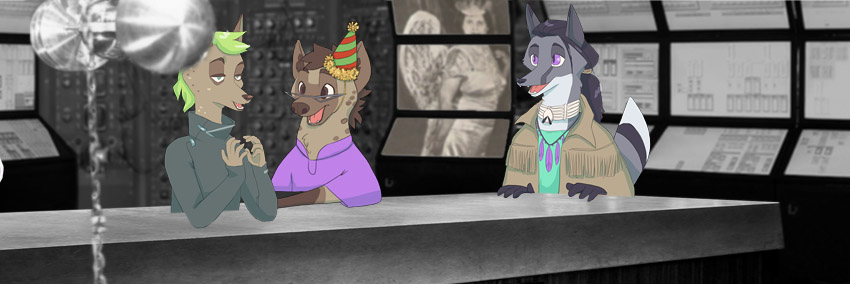Deimos! One asteroid, a million stories! Nine hundred ninety nine thousand, nine hundred and 26 of them we’ve had to import from worlds with a more robust story exporting industry.
I have no idea how Whines ended up wearing a party hat today…oh well!
Formatting note: still working on how to game out timing and such. We’ll probably start splitting up our recording sessions into two episodes – one topic-heavy one and one that’s lighter with Q&A, game review, and such. Unsure of exactly how this will play out at the microphone, but it seems like a good way to break things out, bring the episode to a reasonable length, and still hold onto the various segments I’d like to include.
Episode 13: This episode we focus on HSD’s analog to “flaws,” the Motivation, Compulsion, and Debt systems.
Sound notes: the endless challenge of controlling my host’s wandering volume levels continues…this episode has a clipped, rushed quality to it, may have been too enthusiastic in cutting back long pauses. Every day, we learn a bit more of what not to do. And then forget it.
This is the only “topic” episode for March, as two of the hosts are staffing multiple cons and a wedding! We’ll slow down (but not podfade) through the end of April.
♃ 1.46 — Starting the topic pretty much immediately, looking at the concept of “Motivations.”
♃ 2.16 — Legacy Memory is an interesting Motivation, one which the rules suggest is something between a guiding personality element and an inborn mutation. It’s a bad case of “echoes of earth,” unique on this list in that it’s something that may seem to be outside of the character’s head and control. In a “motivation as plot point” perspective this makes sense, but it suggests that in a system like White Wolf this would have been something more like the “Haunted” flaw than a personality archetype. (see HSDExt1.0p.23).
♃ 2.42 — Talk about the related motivations: Zealot, Spiritualist, maybe Understanding
♃ 2.50 — I never get tired of this joke, apparently. Cogs (HSD’s playable artificial life form) are unique in the setting in that they have an afterlife, of a sort. When they die their minds get uploaded into a virtual afterlife, which exists physically somewhere in Sol, probably on Ganymede or Mars.
♃ 5.03 — Not my favorite aspect of HSD. I think this is in the rules to emphasize the equipment/tech side of sci-fi, and in the spirit of making the game feel different than a generic setting: the speed-learning of skills (“neuroplexing”), stat augmentation to paranormal levels, and many special abilities are driven by surgical implants and procedures, which are inextricably tied to money. This is an aspect of 1.0 that is at least partially going to be phased out in 2.0, which has something more like an experience/advancement table.
♃ 5.50 — White Wolf’s Archetype system has evolved over time…
♃ 11.11 — “This Had Better Work”/”Hail Mary” die: Twice per game, the player can add a D12 to a skill roll (NOT a combat roll!) This increases the chance of a success by a solid margin, but also increases the chance for a critical: if you roll a 1 on your Hail Mary die, bend over and think about MarsCo.
♃ 11.37 — It’s hard to say exactly what the effect of a single die on your roll will be. We tried to map out a lot of the stats here. It varies, but if your dice pool is small (say, 2 or 3) adding a die increases your chance of success by about 15%. If it’s higher? Not so much.
♃ 12.53 — Opening up the idea of Compulsions, the nearest element HSD 1.0 has to a “Flaw” concept.
♃ 16.13 — Poorly chosen triggers…Corbeau’s background is LARPing, a situation that seriously favors the players: a small number of harried storytellers with a swarm of players that swap characters without necessarily telling the GM what they’re up to. In that ecosystem, flaws that don’t have a meaningful trigger…they just don’t come up. In the Hero system, if you pick “Swans” as a huge flaw, the GM should plan to write swans into every campaign. But that’s an unreasonable burdon on the GM. This is an unwinnable loop…but a way to start “winning” is to be sure that any trigger is easy to press.
♃ 16.13 — In the GURPS game system, flaws like “berzerk” and “compulsive shopper” are triggered by an IQ roll, a 3D6 roll against the PC’s main mind stat. At an “average” IQ of 12, it triggers a little under half the time. While your IQ could theoretically go as high as you had the points for, its maximum for these willpower-type rolls was something like 15 or 16. At least that was the case, I can’t find the mechanic in 4th ed.
♃ 17.30 — Exaggerating a bit there, “Consumption” characters can become something like a stunt-swallower, with a secret stomach pouch.
♃ 20.10 — The simple and bold personality element is a useful tool for new RPG players, and one of the reasons why I think Alignment is a good mechanic in D&D and Rifts, and glad to see it go in anything targeting a more sophisticated table.
♃ 21.29 — After this discussion, we went and built a file of home rule ideas for fixes to motivation/compulsion.
♃ 22.00 — The thief that steals from the party…allegedly, this was “cute” when TSR put the light-fingered, klepto kender into the Dragonlance setting. Oh, hah hah, if something goes missing check the Kender’s pockets. Funny once, if at all. The amount of suspension of disbelief this one causes for a party of people who, well, act like people…
♃ 22.04 — apparently “Third time spanking” is from the “Ramona” series?
♃ 24.57 — Here’s a solid little article about shadow totems. They’re threatening, but still a part of the individual. It’s a neat concept and one that fits well in a gaming mindset.
♃ 31.30 — Part three, debt! We opened this up during “The Cog Episode” because Cogs can start the game with a loan from ASR, their home corporation–a rule that we’ve houseruled onto other characters with game master approval.
♃ 37.00 — I blew this literary reference, it was actually Panurge from “Gargantua and Pantegruel,” a substantially older version of the same over-the-top wastrel character. Here’s his speech on debt.
♃ 42.16 — “The Verge” reviews Black Mirror’s episode, “Nosedive.” This one feels very real to me.
With thanks to Sirius Beat for our intro music, “Future Club,” and outro music, “Tronicles.” Our fun, modular header art is by Absyfield , (Thank you Ashley!) and Whines is our audio engineer.
Podcast: Play in new window | Download
Subscribe: RSS

